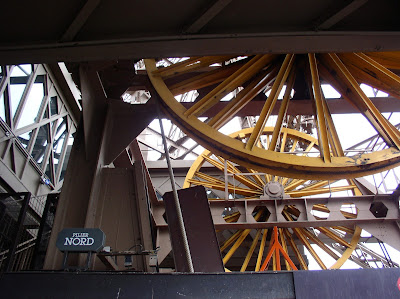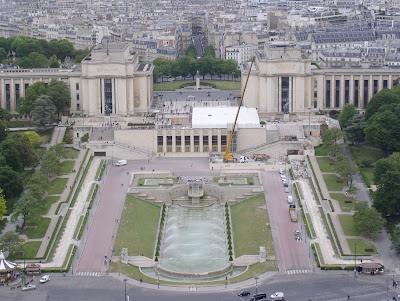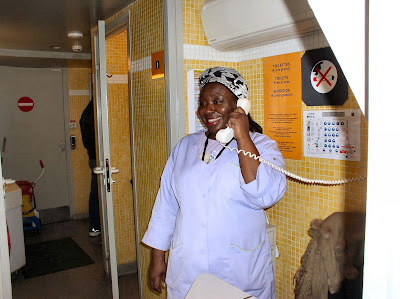“We, writers, painters, sculptors, architects, passionate lovers of the beauty, until now intact, of Paris, hereby protest with all our might, with all our indignation, in the name of French taste gone unrecognized, in the name of French art and history under threat, against the construction, in the very heart of our capital, of the useless and monstrous Eiffel Tower, that public spite, often marked by good sense and a spirit of justice, has already baptized the Tower of Babel.
However, once the tower was finished, the criticism dissipated in light of the completed masterpiece and the enormous popular success with which it was greeted. It received two million visitors during the World's Fair of 1889.
You really have no idea of the sheer size of the Eiffel Tower until you stand beneath it. It is 324 meters (1,063 ft) tall, about the same height as an 81-story building. The tower held the record as the world’s tallest structure until the construction of the Chrysler Building in 1930. It was originally built to serve as an elaborate entranceway into the 1899 Paris World’s Fair at a cost of seven million eight hundred thousand gold francs, a tidy sum of money in those days. However, because it was the highest structure in the world at that time, and everybody who came to the exhibition wanted to get to the top of it, the Eiffel Tower almost paid for itself the first year.
The three platforms
The first platform is 187 feet above the ground and has a floor area of 47,500 square feet. There are souvenir shops, a restaurant and a post office on this level. From there, the tower continues in a slight curve to the much smaller second platform, which is 377 feet above the ground. The second platform has an area of 15,400 square feet. There are telescopes, shops and an elegant restaurant on the second level. Then, the tower rises in a single column of steel framework to a height of 984 feet. The topmost platform has a floor area of 2600 square feet. Eiffel’s private apartment is located on this level. When the tower became a broadcasting tower, another 22 feet were added, so it is now 1,063 feet high. Six and one-half million people visit the Eiffel Tower every year, and 95% of them want to visit the top floor.
Approaching the Eiffel Tower
I took a skip-the-line, two-hour guided tour of the Eiffel Tower, so there was no waiting in a long line. Coming from the Avenue de la Bourdonnais, one of the streets parallel to the Champ-de-Mars, our group took walkways winding around and through gardens on the Champ-de-Mars.
Champ-de-Mars gardens
This approach is through a picturesque park right next to one of the pillars. Another approach to the tower is from the Trocadéro Esplanade across the Seine, which is said to offer the best view of the tower.
Bianca, a charming young woman from Hungary, was our guide.
Engraved Names
On the Eiffel Tower, seventy-two names of French scientists, engineers, and mathematicians are engraved in recognition of their contributions. Many of the scientists are also memorialized as streets in Paris. The engravings are found on the sides of the tower under the first balcony. The letters were originally painted in gold and are about 60 cm (2 feet) high.
Looking straight up into the tower, you can see the tennis ball with the name, “Roland- Garros,” the tennis venue for the French Open.
The Champ-de-Mars
The Champ-de-Mars, in a view southeast from the second level of the Eiffel Tower, is roughly eight hundred feet wide and a little less than half a mile long. It stretches from the Seine River to the Military Academy. The gardens are crossed by two broad avenues, and two avenues shaded by chestnut trees are parallel to each side of the garden (Avenue de la Bourdonnais, which was our group’s approach to the tower, is on the far left of the photo.)
A clay tennis court on the Champ-de-Mars
The "Roland-Garros in the City" event took place on this court in 2014. Three boys and three girls from India, China and Brazil played the final phase of a tennis competition here during the French Open, May 25 - June 8.
Looking down from the tower at a small garden with a fountain and park benches. This garden is close to the east pillar of the tower.
Looking down from the tower at a small garden with a lamp pole in the middle and park benches around the edge. This garden is close to the north pillar of the tower.
Views across the Champ-de-Mars
The Champ-de-Mars extends from the Seine to the École Militaire at its other end. This huge field gets its name, “Field of Mars,” from the fact that it used to be the parade grounds for the Military Academy, “Mars” being the Roman god of war. The Military Academy is a long, rambling building with a dome in the center. The two wings of the school extend for two city blocks on each side. Napoleon entered this school when he was only fifteen and left it a year later as a lieutenant of artillery.
The size and openness of the Champ-de-Mars made it an ideal meeting place for large public gatherings, some of the most famous of which took place during the French Revolution. Les Invalides is the gold-domed building on the left, and the Tour Montparnasse is the skyscraper in the background.
A closer look at Les Invalides, originally a hospital and retirement home for war veterans, built by Louis XIV. You can also see the largest and second largest churches in Paris: Notre-Dame, on the left is in the distance, and Saint-Sulpice, directly above the gold dome, is on the right.
Across the Pont Alexandre III with the 4 pillars mounted by golden statues, you can see the Grand Palais on one side of the street and the Petit Palais on the other side. Above the bridge is the Place de la Concorde, with the obelisk in the center. The Tuileries Garden and Musée du Louvre are to the right of the Place. The building with the green roof is the Église Madeleine. Views of Paris from the Eiffel Tower really are unparalleled.
Tour boats regularly cruise the Seine River.
Les Jardins du Trocadéro with fountains, the two wings of the Palais de Chaillot, and the Esplanade du Trocadéro. La Défense, a major business district of Paris just west of the city, is in the background.
Esplanade du Trocadéro
The open, level space between the wings of the Palais de Chaillot offers the most panoramic view of the Eiffel Tower.
Robert and Becky on the Place du Trocadéro
The Bois de Boulogne is a huge public park on the western side of Paris.
Île des Cygnes (Swans) is a small man-made island in the Seine. In the time of Louis XV, swans were imported from Denmark and Sweden to populate the island, but now only the name remains.
Île des Cygnes and Statue of Liberty
A tree-lined walkway, named "l'Allée des Cygnes," runs the length of the island. At the far end of the island is a 35-foot replica of the Statue of Liberty. This monument was given to the city of Paris by the Parisian community of America. Its base carries a commemorative plaque, and the tablet in its left hand bears the inscription IV Juillet 1776 = XIV Juillet 1789, recognizing the American Independence Day and Bastille Day.
Champagne Bar
At a height of 984 feet, this is the third platform of the tower. The bar offers a selection of pink or white Champagne, served perfectly chilled, to enjoy while contemplating an unobstructed view of Paris. And as early in the day as it was, if the Champagne Bar had been open, we would have celebrated our ascent to the top. The trip going up that high was unexpectedly scary.
Les Toilettes
Also unexpected was a restroom at the top of the tower. The person in charge was pleasant but determined to keep things going in an orderly fashion.
Gustav Eiffel’s Office
At the highest level of the tower, which is now open to the public, Eiffel had built himself a small apartment. It was simply furnished, like a 19th-century Parisian home, including carpets, wallpaper, cabinets, and a small bedroom. Nevertheless, the apartment was the envy of many Parisians, and Eiffel reportedly received several substantial offers for a single night in the apartment. Eiffel refused any and all offers to rent it out and reserved admittance to this unique space only to his prestigious guests. I have to admit that seeing this apartment was the real reason I wanted, once again after many years, to go up in the Eiffel Tower. I’m glad I saw the apartment; moreover, I forgot what panoramic views there are from the tower, so I enjoyed this touristy venue even more than I expected to.
Eiffel’s daughter, Claire, one of Eiffel’s five children (three girls and two boys.)
Thomas Edison
On September 10, 1899, one of Eiffel’s prestigious visitors was Thomas Edison, who spent time with Eiffel smoking cigars, drinking cognac, and discussing Edison’s latest invention, the phonograph. Edison gave Eiffel “one of his newfangled phonograph machines.”
Edison and Eiffel in the cozy pied à terre at the top of the Eiffel Tower






























